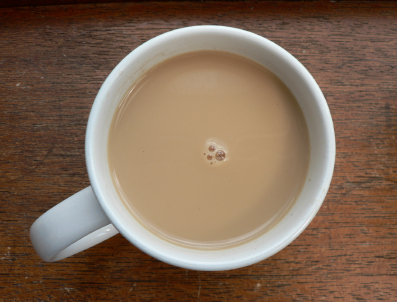A magazine where the digital world meets the real world.
On the web
- Home
- Browse by date
- Browse by topic
- Enter the maze
- Follow our blog
- Follow us on Twitter
- Resources for teachers
- Subscribe
In print
What is cs4fn?
- About us
- Contact us
- Partners
- Privacy and cookies
- Copyright and contributions
- Links to other fun sites
- Complete our questionnaire, give us feedback
Search:
Computing your cuppa

Where would the Eastender inhabitants of Walford be without a cuppa to help them through all of their TV dramas? Little do they realise that lurking in that cup is a little bit of computer science. (Cut to close up of shocked look of horror on Dot Cotton’s face, and cue the drums.)
Sebastian Michaëlis works as a taster/blender for Tetley tea and here he explains the computation behind your cuppa.
Tea, like wine and coffee, is a crop that varies hugely in taste depending on climate, soil and manufacture. As the tea available from around the world is so varied and changeable, it is the job of the Taster to choose the best teas to blend together so that every Tetley teabag tastes the same when you brew it.
In order to do this we have to categorise or 'fingerprint' every batch of tea that we buy (a batch is about 2000kg of tea that tastes the same). We use a specially developed language to assign precise numbers to these batches. These are based on four categories:
- zing – the strength of flavour
- body – how thick or thin a tea is
- colour – from very yellow through to very red
- sparkle – the purity of the colour
To give you an example, a grading of '13-16-34-17' would be a typical grading for an East African tea.
As soon as a batch of tea has been fingerprinted, these numbers will be entered onto our blending computer. We have programmed the computer with many mathematical rules to recognise that mixing a 12 zing tea with a 14 zing tea, for instance, will produce a blend with a zing of 13. Using a database of thousands of batches it will choose the best mix that'll achieve the right characteristics we are looking for. There are approximately 22 billion possible combinations that it may choose from the 20,000 batches of tea that we buy a year (that's about 55 million kilos!). We will change the recipe regularly, so two Tetley tea bags packed on different days may have very different teas in it. Using our tasting language and our blending system we are able to ensure that our tea will always taste the same.
So there you have it, even in your daily cuppa there is computing. Gets everywhere doesn’t it.


